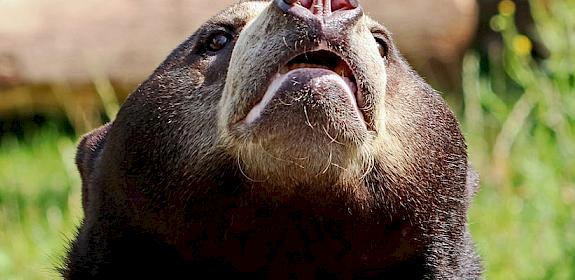Hunting a key factor in Orangutan’s decline
Cambridge, UK, 11th August—Hunting appears to have been significantly underestimated as a key reason for the historical decline of Orangutans, according to a new study published today.

An international team of scientists noted how animal collectors operating in the mid-19th Century in Borneo were able to shoot Orangutans on a daily basis and speculated that 150 years ago, encounter rates with the forest primates must have been far higher than they are today.
To test the hypothesis, the researchers attempted to quantify historic encounter rates from information contained in hunting accounts and museum collections and comparing them to recent field studies.
“Even after allowing for variations in the size and length of hunting and survey expeditions and other variables, we estimated that daily encounter rates with Orangutans have declined by about six-fold in areas with little or no forest disturbance,” said Dr Erik Meijaard, of People and Nature Consulting International in Indonesia, the lead author of the study.
Possible explanations for the decline were examined, including habitat loss and degradation, hunting, disease, and even changes in behaviour, such as animals becoming more wary in the face of human persecution.
“Although there are gaps in the data, after examining several possible explanations, we concluded that high levels of hunting was the most likely cause of the reduced encounter rates over time,” said Dr Vincent Nijman, of Oxford Brookes University, a co-author of the study.
Despite legal protection, hunting of Orangutans still occurs and may have had a more significant impact on wild populations than previously realized.
According to Meijaard, recent unpublished studies in Indonesian Borneo suggest that more than 1,000 Orangutans are killed annually.
Orangutans are hunted for a variety of reasons, including food, as agricultural pests, and to obtain young individuals for the pet trade.
Hanging in the balance, an assessment of trade in gibbons and orangutan in Kalimantan, Indonesia, a TRAFFIC report published in 2005 found that the vast majority of Orangutans in trade were young animals, suggesting that the adult females had been hunted.
“We need to understand better how Orangutan populations are affected by different levels of hunting pressure,” said Nijman.
“Indeed, our findings may force us to rethink the whole biology of Orangutans. Much of our current ecological understanding is possibly based on field studies of animals living at densities below those that would be imposed by food availability.”
“How would the species behave if natural densities were 5 or 10 times higher than those we currently observe?”
Declining orangutan encounter rates from Wallace to the present suggest the species was once more abundant by Erik Meijaard, Alan Welsh, Marc Ancrenaz, Serge Wich, Vincent Nijman and Andrew J. Marshall, is available from PLoS One.



